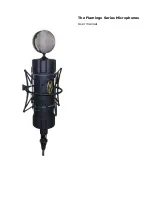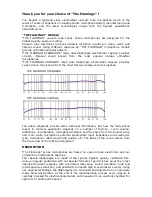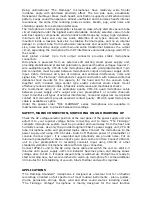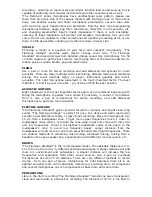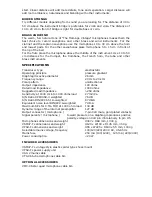
recording - orienting on lead vocals and similar function lead sound sources, but is
capable of capturing most musical instruments and other sound sources as well.
“The Flamingo” series microphones have unidirectional polar pattern, please use
them from an active side of the capsule marked with Flamingo logo on microphone
body. Use possibly quality and linear microphone preamplifier, vacuum tube units
with switching input transformers are preferable. Find the best tone manipulating
microphones distance, angle, pop filter, windscreen, reflectors, room’s acoustic, etc,
and changing preamplifier input’s (load) impedance if there is such possibility.
Lowering of input impedance will warmer and sweeten microphones tone and vice
versa. Do not use equalizers, other corrections and dynamic processing at all, or use
them so little as possible, orienting corrections to down (minus) side.
VOCALS
Choosing a model is a question of your taste and vocalist's individuality. “The
Flamingo Vintage” provides warm classic vintage vocal tone. “The Flamingo
Standard” provides wider spectrum detailed vintage sound. Use microphones 5 to 50
cm from capsule to get the best results. Use the pop filter or the foam windscreen to
reduce plosive sounds, breath, pop and wind noises.
PIANO
Use a pair or more for stereo recording and add distanced microphones for room
acoustics. There are many methods with close miking, distance miking and combined
miking. The result depends highly on player, instrument qualities and room's
acoustics. The right microphone placement is the most important factor. The best
method is to find it by your own ears – go, listen and find the best position.
ACOUSTIC GUITARS
Right placement is the most important factor again. We recommend beginning with
facing the microphone to guitars' neck, where it joins body, in some 10 cm distance
from it. Use a pair of microphones for stereo recording, and add distanced
microphones to get more room acoustics.
ELECTRIC GUITARS
"The Flamingo Standard" gives excellent results for dynamic and bright clean amp
sound, “The Flamingo Vintage” is perfect for juicy, fat, dense and warm lead guitar
overdrive and distortion sounds, or jazzy tones recording. Place the microphone 5 to
15 cm from a loudspeaker cone. To get more upper frequencies move it closer to
loudspeaker cones center, or toward the cone edge to get fuller tone with more mid
and low frequencies. Orient a microphone’s diaphragm under some angle to the
loudspeaker’s cone to avoid low frequency peaks. Larger distance from the
loudspeaker will add more air and room acoustics and soften high frequencies. There
are endless methods of combining close miking, distanced miking, miking from a
backside of an open speaker box, experimenting with different room acoustics, etc.
DRUMS
“The Flamingo Standard’ is the recommended model. The advisable distance is 5 to
15 cm from a drum rim, try different positions and angles. A bigger distance will add
more air, environment and naturalness. A smaller distance will increase the low
frequencies and separation from other sound sources. Use a pair as overhead
microphones at some 70 cm distance. There are very different methods to record
drums - from one pair of stereo microphones for right balanced drum kit in an
optimal acoustics room until individually miked every sounding drum kit component
and several microphones on such components as bass drum and snare drum.
PERCUSSIONS
Like on the drum recording "The Flamingo Standard" microphone gives transparent,
clean and real results in percussions recording. The distance of 30 cm is the best to

